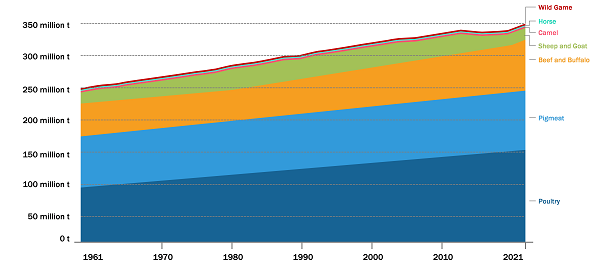
Published On: Apr 2025

Published On: Apr 2025

At 3.3% CAGR, Middle East & Africa Feed Anticoccidials Market is Projected to be Worth US$ 91.26 Million by 2031, says Business Market Insights
According to Business Market Insights' research, the Middle East & Africa feed anticoccidials market was valued at US$ 70.20 million in 2023 and is expected to reach US$ 91.26 million by 2031, registering a CAGR of 3.3% from 2023 to 2031. Increase in livestock production and increase in livestock production are among the critical factors attributed to the Middle East & Africa feed anticoccidials market expansion.
Industrial livestock production has undergone a significant transformation owing to increasing demand for meat-based products and dairy products. Animal protein accounts for 16% of energy and 34% of the protein in human diets. Livestock production also accounts for ~19% of the value of food production and 30% of the global value of agriculture. The demand for livestock products is driven by changing lifestyles and food preferences, increasing urbanization, growing income, and the rapidly rising world population. With burgeoning livestock demand, the consumption of protein-rich meat products is upsurging. According to the Food and Agriculture Organization (FAO), worldwide meat protein consumption is predicted to increase by 14% by 2030.
World milk production is expected to rise by 1.6% annually between 2020 and 2029 and reach 997 million metric tons by 2029, according to a report by the Organization for Economic Co-operation and Development (OECD) and FAO. Thus, with the increasing consumption of livestock products such as meat and milk, the production of healthy livestock is increasing across the globe. The rising production has encouraged manufacturers to focus on the feed given to the livestock.
As shown in the following figure, according to the FAO, the total meat production globally was 235.06 million metric tons in 2001, significantly increasing to 354.82 million metric tons in 2021. Poultry production accounted for a notable growth of 93% from 2001 to 2021.
Global Meat Production by Livestock Type (2001-2021)

Source: Food and Agriculture Organization (FAO) of the United Nations
The growth in livestock production is likely to create a demand for feed anticoccidials to fight against diseases such as coccidiosis. Livestock farmers are also concerned about the health of livestock. Thus, they are adopting various strategies to fight against diseases and investing in feed antibiotics such as anticoccidials. These feed anticoccidials are significantly used as a poultry feed additive. They are also used in the feed of swine, ruminants, and aquaculture. Thus, the upsurging livestock production drives the feed anticoccidial market growth.
On the contrary, stringent regulation on use of antibiotics in animal feed hamper the growth of Middle East & Africa feed anticoccidials market.
Based on type, the Middle East & Africa feed anticoccidials market is segmented into ionophore, chemical anticoccidials, and chemical-ionophores. The ionophore segment held 50.4% market share in 2023, amassing US$ 35.40 million. It is projected to garner US$ 44.75 million by 2031 to register 3.0% CAGR during 2023-2031.
In terms of form, the Middle East & Africa feed anticoccidials market is bifurcated into dry and liquid. The dry segment held 96.6% share of Middle East & Africa feed anticoccidials market in 2023, amassing US$ 67.81 million. It is projected to garner US$ 88.02 million by 2031 to expand at 3.3% CAGR during 2023-2031.
Based on livestock, the Middle East & Africa feed anticoccidials market is segmented into poultry, ruminants, swine, and others. The poultry segment held 84.7% market share in 2023, amassing US$ 59.47 million. It is projected to garner US$ 76.88 million by 2031 to register 3.3% CAGR during 2023-2031.
Based on country, the Middle East & Africa feed anticoccidials market has been categorized into Saudi Arabia, South Africa, the UAE, and the Rest of Middle East & Africa. Our regional analysis states that the Rest of Middle East & Africa captured 65.8% share of Middle East & Africa feed anticoccidials market in 2023. It was assessed at US$ 46.22 million in 2023 and is likely to hit US$ 58.97 million by 2031, exhibiting a CAGR of 3.1% during 2023-2031.
Key players operating in the Middle East & Africa feed anticoccidials market are Phibro Animal Health Corp, Zoetis Inc, Kemin Industries Inc, Elanco Animal Health Inc, Huvepharma EOOD, Impextraco NV, and Virbac SA., among others.
Contact Us
Phone: +16467917070
Email Id: sales@businessmarketinsights.com